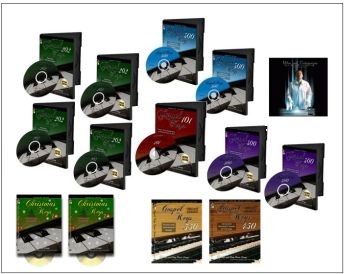
How do I go about learning a song by ear?
Here's my answer to the question. When I listen to songs...
1. Find the melody (some of it first) and listen for where a song resolves. For example, at the end of the verse, you can hear the I chord (one chord) or the "tonic" chord. That tells you the key the song is in. When you know the key, then you can figure out the progressions from there, usually. And, it just takes time to hear major or minor keys.
2. Next, listen for bass notes. Most of the time you can hear the bottom the best, and then you figure out what chords will go with that bass note. I can hear "suspended" chords well (C F G) and augmented chords(a chord w/a sharp 5th) for instance C(#5) is C E G#. I can also hear a bass note with a different chord over it, for instance C\G = LH/RH G\C E G. Listen for your bass notes. Once you have your bass notes and a pattern, go from there.
3. Organization is the key. Type out the words, while listening to the CD. Stop, start, stop, and start. Get all the words typed out with space in between each line to write. This way, you can see and hear, the verses, choruses and vamps. So many songs are so much alike (at least very similar) that once you start to really engage your ears, you find you can play one song, and you can play 4 or 5 others you like.
4. Successful ear players have a plan, and a method. Find your own method. I need to "hear" things over and over, hearing the patterns, the chords, and paying attention to what's repetitive in the song.
5. Harmonize the melody. The melody note, that is the soprano part if it's a choir singing. Build your chord beneath that melody note and you have the choir parts too!
So, is it possible to Play The Piano By Ear?
* Yes, the ability to play a piece of music is simply listening to it repeatedly!
* Repetition is a great way to understand a song and chord structure.
* Figuring out the notes and rhythms to a song helps you to learn how to effectively structure a song in that particular genre.
* Playing by ear is also beneficial in helping a musician develop his or her own style; creating something distinctive, something indicative of them only.
* Learning music is the same as learning a language; it's acquired by years of hearing it, eventually coupled with formal training.
* Anyone can learn enough about the basics of playing by ear if they learn the following skills:
Being able to hear a tune and have a general sense of the contour of the melody -- when the tune moves higher or lower as the song progresses.
Learning to chart that melody contour either on paper or in their memory.(as mentioned earlier).
Learning to match the melody to appropriate chords.
Playing by ear is really a combination of three factors:
1. Using your tonal memory to recall music you have heard:
2. Using your ears and fingers to help you reproduce what you recall;
3. Using "melody contour" (the "shape" of the tune), "chord structure" (how to form the chords on the keyboard to match the tune), and "chord progressions" (the path chords take as they move through a song).
The real key to playing by ear is learning how to chart the shape of a tune, learn how to construct chords, and then determine the likelihood of chord progressions -- in other words, which chord comes next.
I have purchased these resources from HearandPlay and believe these are the best Books, Cds and Dvds on learning how to play a song by ear. Read more here and order today if you're serious about learning how to play a song by ear!
Learn To Play By ear
Learn To Play Any Song By Ear
Learn Chords
http://www.LadyDpiano.com









 Hi,
Hi,






















